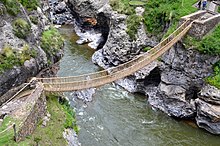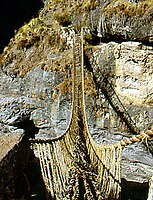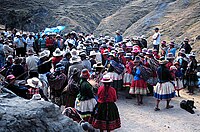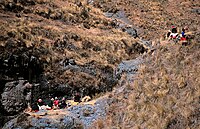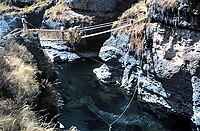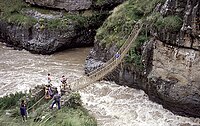
A suspension bridge is a type of bridge in which the deck is hung below suspension cables on vertical suspenders. The first modern examples of this type of bridge were built in the early 1800s. Simple suspension bridges, which lack vertical suspenders, have a long history in many mountainous parts of the world.

Machu Picchu is a 15th-century Inca citadel located in the Eastern Cordillera of southern Peru on a 2,430-meter (7,970 ft) mountain ridge. Often referred to as the "Lost City of the Incas", it is the most familiar icon of the Inca Empire. It is located in the Machupicchu District within Urubamba Province above the Sacred Valley, which is 80 kilometers (50 mi) northwest of Cusco. The Urubamba River flows past it, cutting through the Cordillera and creating a canyon with a tropical mountain climate. In reference to the site's name, for most English or Spanish speakers, the first 'c' in Picchu is silent. In English, the name is pronounced MAH-choo PEE-choo or MATCH-oo PEAK-choo, in Spanish as or, and in Quechua as.
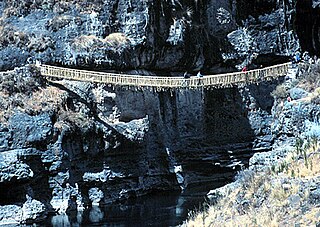
Inca rope bridges are simple suspension bridges over canyons, gorges and rivers (pongos) constructed by the Inca Empire. The bridges were an integral part of the Inca road system and exemplify Inca innovation in engineering. Bridges of this type were useful since the Inca people did not use wheeled transport – traffic was limited to pedestrians and livestock – and they were frequently used by chasqui runners delivering messages throughout the Inca Empire.

The Inca road system was the most extensive and advanced transportation system in pre-Columbian South America. It was about 40,000 kilometres (25,000 mi) long. The construction of the roads required a large expenditure of time and effort.

Juliaca is the capital of San Román Province in the Puno Region of southeastern Peru. It is the region's largest city with a population of 276,110 inhabitants (2017). On the Altiplano, Juliaca is 3,825 metres (12,549 ft) above sea level, is located on the Collao Plateau and is northwest of Lake Titicaca (45 km). It is the largest trade center in the Puno region.

The Inca religion was a group of beliefs and rites that were related to a mythological system evolving from pre-Inca times to Inca Empire. Faith in the Tawantinsuyu was manifested in every aspect of his life, work, festivities, ceremonies, etc. They were polytheists and there were local, regional and pan-regional divinities.

A simple suspension bridge is a primitive type of bridge in which the deck of the bridge lies on two parallel load-bearing cables that are anchored at either end. They have no towers or piers. The cables follow a shallow downward catenary arc which moves in response to dynamic loads on the bridge deck.
Mit'a was mandatory service in the society of the Inca Empire. Its close relative, the regionally mandatory Minka is still in use in Quechua communities today and known as faena in Spanish.

Inca architecture is the most significant pre-Columbian architecture in South America. The Incas inherited an architectural legacy from Tiwanaku, founded in the 2nd century B.C.E. in present-day Bolivia. A core characteristic of the architectural style was to use the topography and existing materials of the land as part of the design. The capital of the Inca empire, Cuzco, still contains many fine examples of Inca architecture, although many walls of Inca masonry have been incorporated into Spanish Colonial structures. The famous royal estate of Machu Picchu is a surviving example of Inca architecture. Other significant sites include Sacsayhuamán and Ollantaytambo. The Incas also developed an extensive road system spanning most of the western length of the continent and placed their distinctive architecture along the way, thereby visually asserting their imperial rule along the frontier.

Písac or Pisac is a Peruvian town in the Sacred Valley of the Incas. It is situated on the Vilcanota River. Pisac is most known for its Incan ruins and large market which attracts heavy tourist traffic from nearby Cusco.

The Inca society was the society of the Inca civilization in Peru. The Inca Empire, which lasted from 1438 to 1533 A.D., represented the height of this civilization. The Inca state was known as the Kingdom of Cusco before 1438. Over the course of the empire, the rulers used conquest and peaceful assimilation to incorporate a large portion of western South America, centered on the Andes mountain ranges. The empire proved relatively short-lived however: by 1533, Atahualpa, the last Sapa Inca (emperor) of the Inca Empire, was killed on the orders of the conquistador Francisco Pizarro, marking the beginning of Spanish rule. The last Inca stronghold, the Neo-Inca State in Vilcabamba, was conquered by the Spanish in 1572.
The term Peruvian literature not only refers to literature produced in the independent Republic of Peru, but also to literature produced in the Viceroyalty of Peru during the country's colonial period, and to oral artistic forms created by diverse ethnic groups that existed in the area during the prehispanic period, such as the Quechua, the Aymara and the Chanka South American native groups.

The Inca Bridge or Inka Bridge refers to one of two places related to access to Machu Picchu, in Peru.

Inca technology includes devices, technologies and construction methods used by the Inca people of western South America, including the methods Inca engineers used to construct the cities and road network of the Inca Empire.
The Incan aqueducts refer to any of a series of aqueducts built by the Inca people. The Inca built such structures to increase arable land and provide drinking water and baths to the population. Due to water scarcity in the Andean region, advanced water management was necessary for the Inca to thrive and expand along much of the coast of Peru. Such structures, some of which survive today, show the advanced hydraulic and civil engineering capabilities of the Inca.

Puka Pukara is a site of military ruins in Peru situated in the Cusco Region, Cusco Province, Cusco District, near Cusco. This fort is made of large walls, terraces, and staircases and was part of defense of Cusco in particular and the Inca Empire in general.
Victoriano Arizapana Huayhua is a Quechua master rope bridge engineer, notable for being the lead builder of the Q'iswa Chaka, which is the last remaining traditionally built Inca rope bridge and a part of the historical Qhapaq Ñan Inca road network. He is also a teacher and cultural figure, preserving and transmitting to future generations the bridgebuilding techniques passed to him by his ancestors.
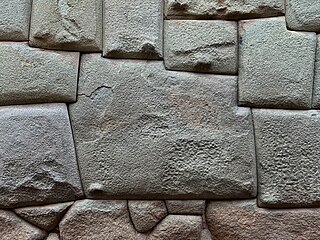
The twelve-angled stone is an archeological artifact in Cuzco, Peru. It was part of a stone wall of an Inca palace, and is considered to be a national heritage object. The stone is currently part of a wall in the palace of the Archbishop of Cuzco.

The economy of the Inca Empire was based on local traditions of solidarity and mutualism, transported to an imperial scale. It was based on the institution of reciprocity, considered the socioeconomic and political system of the Pre-Columbian Andes.

Incan animal husbandry refers to how in the pre-Hispanic andes, camelids played a truly important role in the economy. In particular, the llama and alpaca—the only camelids domesticated by Andean men— which were raised in large-scale houses and used for different purposes within the production system of the Incas. Likewise, two other species of undomesticated camelids were used: the vicuña and the guanaco. The guanacos were hunted by means of chacos.


